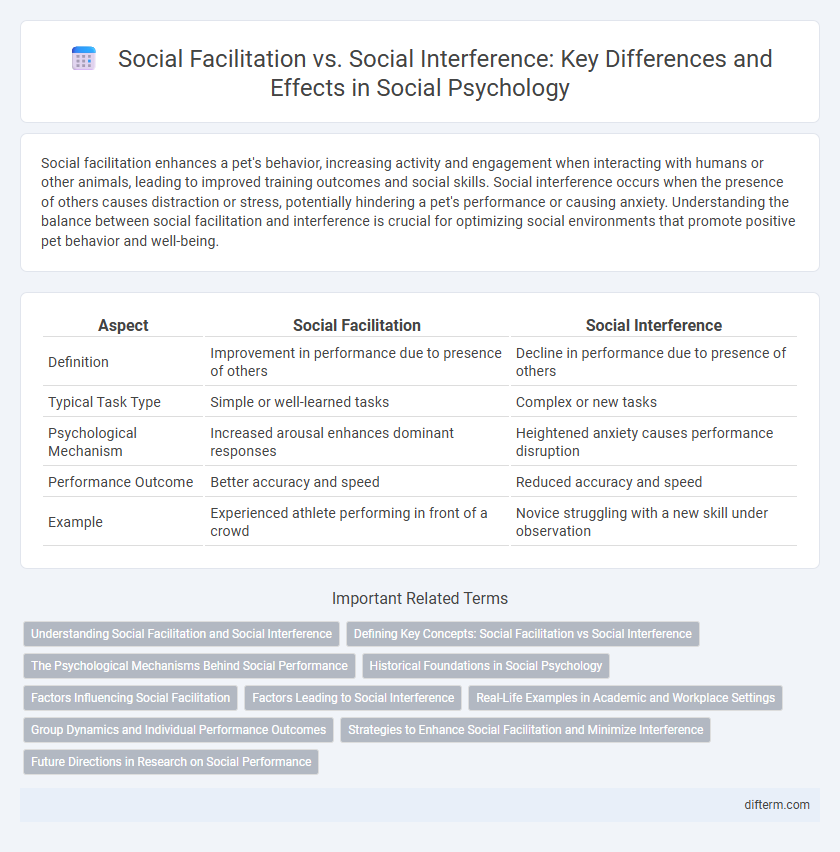Social facilitation enhances a pet's behavior, increasing activity and engagement when interacting with humans or other animals, leading to improved training outcomes and social skills. Social interference occurs when the presence of others causes distraction or stress, potentially hindering a pet's performance or causing anxiety. Understanding the balance between social facilitation and interference is crucial for optimizing social environments that promote positive pet behavior and well-being.
Table of Comparison
| Aspect | Social Facilitation | Social Interference |
|---|---|---|
| Definition | Improvement in performance due to presence of others | Decline in performance due to presence of others |
| Typical Task Type | Simple or well-learned tasks | Complex or new tasks |
| Psychological Mechanism | Increased arousal enhances dominant responses | Heightened anxiety causes performance disruption |
| Performance Outcome | Better accuracy and speed | Reduced accuracy and speed |
| Example | Experienced athlete performing in front of a crowd | Novice struggling with a new skill under observation |
Understanding Social Facilitation and Social Interference
Social facilitation occurs when an individual's performance improves in the presence of others, typically in tasks that are simple or well-practiced, while social interference refers to the decline in performance caused by the presence of others during complex or new tasks. The underlying mechanism involves increased arousal, which enhances dominant responses, thereby facilitating easy tasks and hindering difficult ones. Understanding these phenomena is crucial for optimizing performance in social and professional environments.
Defining Key Concepts: Social Facilitation vs Social Interference
Social facilitation refers to the improved performance on simple or well-practiced tasks when an individual is in the presence of others, driven by increased arousal and motivation. In contrast, social interference occurs when the presence of others causes a decline in performance, typically on complex or new tasks, due to heightened anxiety and distraction. Understanding these key concepts highlights how social environments can differentially impact cognitive and motor task execution based on task difficulty and individual familiarity.
The Psychological Mechanisms Behind Social Performance
Social facilitation occurs when the presence of others enhances an individual's performance on simple or well-practiced tasks due to increased arousal and motivation. In contrast, social interference happens when performance declines on complex or new tasks because heightened anxiety disrupts cognitive processing. The psychological mechanisms involve the interplay of arousal, attention focus, and evaluation apprehension, which either improve or impair task execution depending on task complexity and individual confidence.
Historical Foundations in Social Psychology
Early research in social psychology, including Norman Triplett's 1898 study on cyclists, established the foundation for understanding social facilitation, showing that individuals perform better on simple tasks in the presence of others. Robert Zajonc later expanded this concept by proposing the drive theory, which explains social interference through increased arousal that enhances dominant responses but impairs performance on complex tasks. These historical findings underscore the dual effects of social presence on human behavior, differentiating facilitation from interference within group dynamics.
Factors Influencing Social Facilitation
Social facilitation is influenced by task complexity, with simple or well-learned tasks showing improved performance in the presence of others, while complex or new tasks often suffer from social interference. The presence of an evaluative audience increases arousal and motivation, enhancing dominant response tendencies. Individual differences such as self-confidence and familiarity with the audience also modulate the effects of social facilitation.
Factors Leading to Social Interference
Factors leading to social interference include the complexity of the task, increased pressure from the presence of others, and heightened anxiety or self-consciousness. Complex or unfamiliar tasks often cause performance to decline when observed, as individuals may overthink or become distracted due to evaluation apprehension. Environmental distractions and lack of confidence in social settings further exacerbate social interference, reducing overall effectiveness.
Real-Life Examples in Academic and Workplace Settings
Social facilitation enhances performance on well-practiced tasks, such as students answering familiar questions during class discussions or employees efficiently completing routine assignments under supervision. Social interference occurs when complex or unfamiliar tasks are performed in the presence of others, evident in students struggling with new problem-solving exercises during group work or employees facing difficulty during presentations to management. These examples highlight the impact of audience presence on task execution in academic and workplace environments.
Group Dynamics and Individual Performance Outcomes
Social facilitation enhances individual performance in group settings when tasks are well-learned or simple, driven by increased arousal and motivation. Conversely, social interference occurs during complex or unfamiliar tasks, where the presence of others induces anxiety and impairs execution. Group dynamics, including audience size and evaluative pressure, critically influence whether social facilitation or interference predominates in shaping individual performance outcomes.
Strategies to Enhance Social Facilitation and Minimize Interference
Enhancing social facilitation involves creating supportive environments that boost individual motivation and task performance through positive peer presence and encouragement. Strategies include setting clear goals, providing constructive feedback, and fostering group cohesion to harness arousal effects beneficially. Minimizing social interference requires reducing distractions, managing audience size, and promoting task familiarity to prevent anxiety and avoid performance decline under observation.
Future Directions in Research on Social Performance
Future research on social performance should explore the neural mechanisms underlying social facilitation and social interference, utilizing advanced neuroimaging techniques to map brain activity in real-time social interactions. Investigating individual differences such as personality traits, anxiety levels, and cultural backgrounds will enhance understanding of when social presence improves or impairs task performance. Integrating virtual reality environments can provide controlled, ecologically valid settings to examine complex social dynamics influencing performance outcomes.
social facilitation vs social interference Infographic

 difterm.com
difterm.com